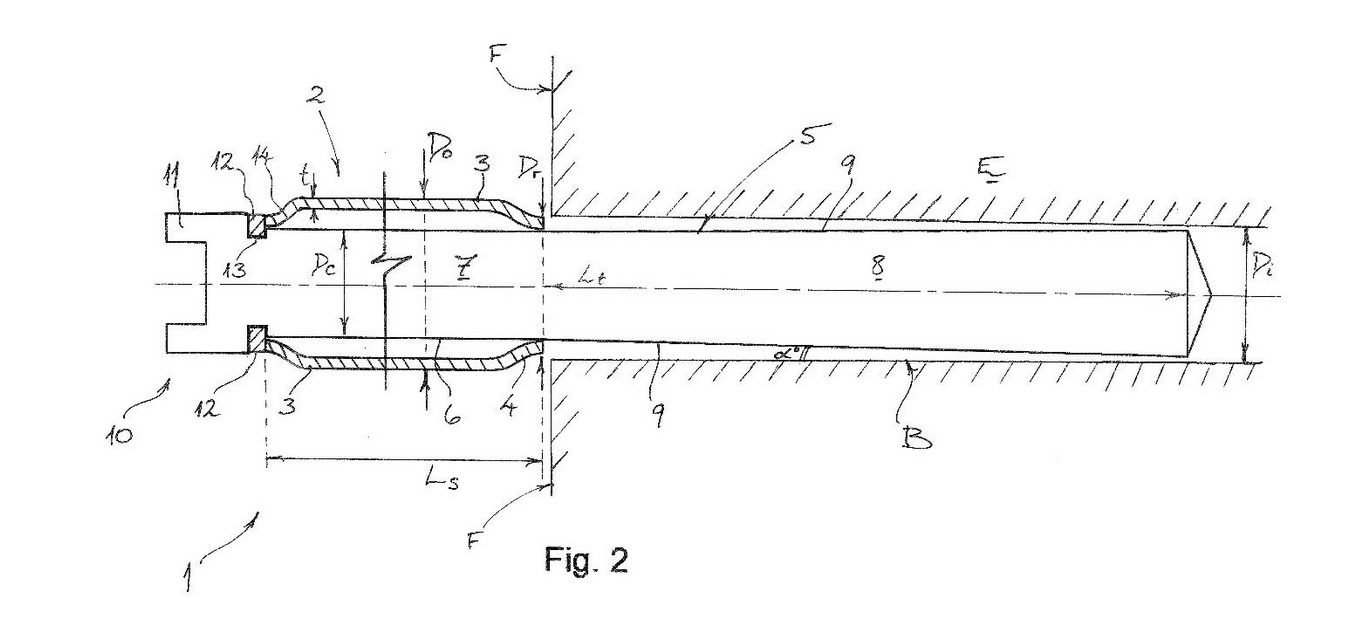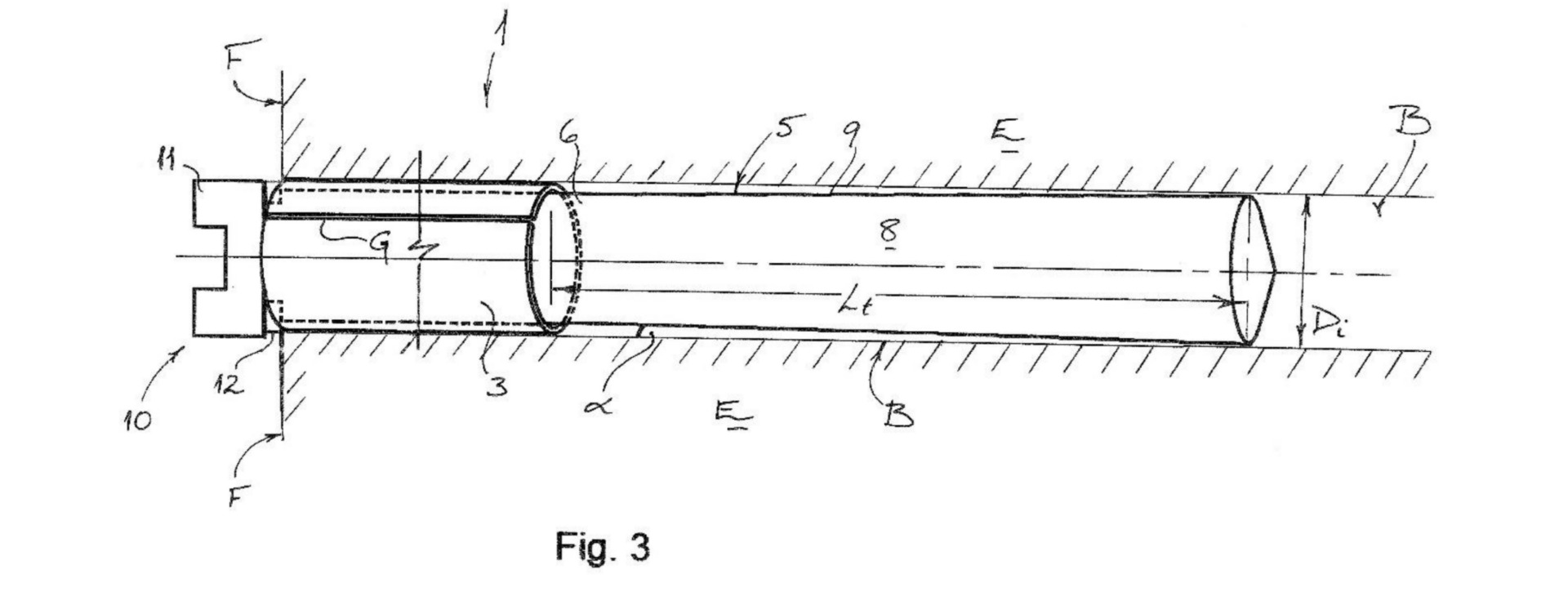Mining Safety Patent Fails

Invariably, whenever a patent is enforced, there are two key arguments:
‘infringement’ – the accused will argue that their product and/or process is not covered by the patent; and
‘validity’ – the accused will argue that the patent is invalid.
In recent court decisions [1] concerning mining safety systems, the accused succeeded on both points.
The invention
Australian patent no. 2019100556 commences with discussion of upwardly drilling bores in the range 20 to 60 metres in length, and the risk of a drill rod breaking and leaving behind 100 to 500 kg of broken drill rod at risk of later falling out.
The patent covers safety systems that rely on wedging action to plug the holes. Two different versions of the safety system are described. The version of Figures 2 and 3 is akin to a masonry anchor. It comprises a Ø100 mm x 8 mm thick steel split-tube 3 fitted to a steel elongate body 6 comprising tapered portion 8. If a broken drill rod falls, it pushes the tapered portion 8 into the sleeve 3 to outwardly drive the sleeve to better engage the bore. Note that the drawings are sideways such that ‘down’ is leftward as drawn.


The version of Figure 4 had a different elongate member 6 including tapered portion 9. The tapered portion 9 and the opposite side of the bore B define a downwardly-narrowing gap to trap a falling drill rod.

For the most part, the key components are said to be formed of steel and there is very little discussion of any other material.
The patent coverage
As is standard practice, the patent covers more than the specific examples. The patent coverage is defined by the patent’s ‘claims’. Claim 1 was the key claim in this case:
- A safety system for protecting against a hazard of drill rod failure in a drilled rock bore above horizontal, and especially a hazard posed by a broken drill rod section within the bore, comprising:
an anchor member [e.g. sleeve 3] configured to be fixed in a proximal end region of the bore adjacent to a rock-face; and
an impact reduction member [e.g. elongate member 6] for reducing an impact of the broken drill rod section striking the anchor member in the proximal end region of the bore, wherein the impact reduction member is configured to be located in the proximal end region of the drilled bore and to extend within the bore above the anchor member to be impacted or struck directly by the broken drill rod section falling within the bore.
Infringement
The accused’s product, sold under the trade mark SafetySpear, performed a similar function and was formed of Nylon 66.

The accused successfully argued that:
- ‘anchor member’ in claim 1 limited the patent coverage to devices that did not move ‘by more than a de minimis amount of about 5 mm when struck by a falling broken drill bit’ (paragraph 99); and
- the patentee ‘had not proven that the SafetySpear travelled by no more than 5 mm down the bore when struck by a falling drill rod section’ (paragraph 102).
Validity
Generally speaking, for a patent claim to be valid, the invention defined by the claim must be ‘novel’ (i.e. strictly new) and have an ‘inventive step’. An inventive step requires non-obviousness – that is, something more than a routine development in the technology or a plain and logical extension of what is already publicly known.
Often, novelty and inventive step are prominent amongst the validity arguments. Not so in this case. In this case, the validity arguments focused on the ‘internal’ validity requirements of ‘sufficiency’ and ‘support’.
At least in theory, at the heart of the patent system is a ‘bargain’ – a 20-year monopoly defined by the claims, in return for publishing a comprehensive document (the text and figures of the patent) that teaches the public how to make and use the invention.
The support and sufficiency requirements are intended to ensure that there is a balance between the two halves of this bargain.
The sufficiency requirement is sometimes called the ‘enablement requirement’, and asks whether the patent adequately teaches how to make and use the invention covered by the claims.
The support requirement relates to whether coverage is justified – that is, to whether the claims exceed the inventor’s technical contribution to the relevant area of technology.
In this case, the patent failed on both the support and sufficiency grounds because:
- the coverage was not limited to any particular material; whilst
- the description focussed (relevantly only) on steel;
- the courts
- accepted the accused’s expert testimony to the effect that there were significant challenges in adopting other plausible materials (such as fibreglass); and in turn
- ‘found that the skilled addressee would need to exercise inventive skill to come up with ways to address the choice of a suitable material and the correlative task of fashioning the Safety System from that material’ (paragraph 213).
More on patent coverage.
Take away points
Whilst the claims will always be critical, this case demonstrates the importance of other aspects of the patent wording. With the benefit of hindsight, the patentee might have won the day if the patent:
- had explained that the anchor member (e.g. sleeve 3) might only loosely anchor the device in place until the device is struck by a broken drill rod, and some movement is acceptable; and
- at least briefly mentioned a few plausible materials other than steel.
It also demonstrates the importance of persuasive expert testimony from suitably qualified experts. Judges are experts in applying the law and are (usually) not technical experts themselves. Hence, the role of technical experts can be crucial.
In this case, in relation to the support and sufficiency issues, the accused’s expert was preferred because he had a background in material science. If the patentee had their time again, they may well have been able to rebut the accused’s expert by presenting expert evidence showing that:
- starting with the information in the patent application, the ‘ordinary non-inventive worker’ could develop versions of the safety system without undue burden; and
- the inventor’s technical contribution is not limited to steel; and thus
- the patent satisfies the sufficiency and support requirements.
[1] concluding with Jusand Nominees Pty Ltd v Rattlejack Innovations Pty Ltd [2023] FCAFC 178
